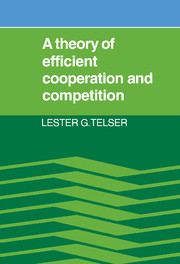Book contents
- Frontmatter
- Contents
- List of tables
- Preface
- Chapter 1 Prologue
- Chapter 2 Perceptions and reality: the genesis of the Sherman act
- Chapter 3 Competition, cooperation, and efficiency
- Chapter 4 Stable coalitions
- Chapter 5 Equilibrium with decreasing average cost: an application of the theory of the core illustrated by production and exchange among spatially separated markets
- Chapter 6 A theory of self-enforcing agreements
- Chapter 7 Some new results on duopoly applied to theories of Cournot, Bertrand, and Edgeworth
- Chapter 8 Rivalry by means of innovation
- References
- Index
Chapter 7 - Some new results on duopoly applied to theories of Cournot, Bertrand, and Edgeworth
Published online by Cambridge University Press: 03 November 2009
- Frontmatter
- Contents
- List of tables
- Preface
- Chapter 1 Prologue
- Chapter 2 Perceptions and reality: the genesis of the Sherman act
- Chapter 3 Competition, cooperation, and efficiency
- Chapter 4 Stable coalitions
- Chapter 5 Equilibrium with decreasing average cost: an application of the theory of the core illustrated by production and exchange among spatially separated markets
- Chapter 6 A theory of self-enforcing agreements
- Chapter 7 Some new results on duopoly applied to theories of Cournot, Bertrand, and Edgeworth
- Chapter 8 Rivalry by means of innovation
- References
- Index
Summary
Introduction
With the aid of clear and explicit assumptions about the nature of the cost and demand conditions, one can expose the inner structure of the mechanism underlying the theories of duopoly proposed by Cournot in 1838, Bertrand (1883), and Edgeworth (1925). These theories have been the subject of continuous analysis by many economists over a long period of time and remain the starting point of all contributions to this subject. Despite this, their theories are ambiguous because they lack clear descriptions of the economic reality they purport to explain. The standard these theories ought to satisfy is this. It should be possible to state the rules for the situations they describe with enough clarity so that treated as a game, in the sense that poker is a game, the participants would know precisely what they can do under the various circumstances that can occur. The models I shall describe intend to meet this criterion.
The difference between Cournot's theory and the Bertrand–Edgeworth theories are the topic of the next section. Briefly, the Cournot model assumes the duopolists choose output and allow the demand conditions to determine the price at which the total output can be sold. The Bertrand–Edgeworth models allow the duopolists to choose their prices. Consequently, there is the question of what happens if a firm is unable to fill the demand forthcoming at this price or if the demand is below the firm's expectation.
- Type
- Chapter
- Information
- A Theory of Efficient Cooperation and Competition , pp. 220 - 241Publisher: Cambridge University PressPrint publication year: 1987



